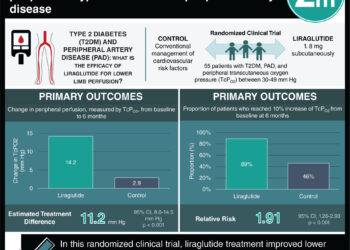Prolonged DAPT following PCI linked to fewer ischemic events in patients with PAD
1. Subgroup analysis of the PRODIGY trial demonstrated that there were lower rates of ischemic events in patients with baseline peripheral artery disease (PAD) who received prolonged (24 months vs. <6 months) dual antiplatelet therapy (DAPT) following percutaneous coronary intervention (PCI).
2. Patients without PAD at baseline were less likely to experience subsequent ischemic events and were not shown to benefit from prolonged DAPT therapy.
Evidence Rating Level: 2 (Good)
Study Rundown: Optimal duration of DAPT following PCI remains an area of ongoing investigation with the benefits of preventing further ischemic events needing to be weighed against bleeding risk and other side effects. Patients with PAD are known to have higher risk of coronary artery disease and have been shown to be at higher risk of cardiovascular mortality following PCI. This study was a subgroup analysis of the Prolonging Dual Antiplatelet Treatment After Grading Stent-Induced Intimal Hyperplasia Study (PRODIGY) randomized control trial and sought to evaluate whether the presence of PAD influenced outcomes with short vs. prolonged DAPT following PCI.
The PRODIGY trial was designed to compare prolonged (24 months) use of DAPT with short duration (<6 months) following PCI. Subgroup analysis showed that patients with PAD at baseline had increased risk of the primary combined outcome of death, MI, or CVA, as well as increased mortality. Prolonged DAPT was associated with improved primary outcomes for those with PAD but not for those without PAD. Prolonged DAPT was not shown to have increased risk of major clinical bleeding. This subgroup analysis demonstrated the significant prognostic importance of baseline PAD on future ischemic risk. The benefit from prolonged DAPT in this population offers an option to reduce the risk of subsequent ischemic events. PAD may therefore be used as a way to stratify patients for decision to continue DAPT. The limitations of this study included the use of only ASA and clopidogrel for anti-platelet agents when newer agents are available, and the potential bias of the retrospective analysis given that PAD was not initially used to help balance the randomization of the trial.
Click to read the study, published today in JAMA Cardiology
In-Depth [randomized controlled trial]: This study was a subgroup analysis of the previously reported Prolonging Dual Antiplatelet Treatment After Grading Stent-Induced Hyperplasia Study (PRODIGY) trial that compared outcomes with short (≤6 months) and prolonged (24 months) DAPT with ASA plus clopidogrel following PCI. The subgroup analysis compared those with baseline PAD (n = 246) to those without (n = 1724). Patients were followed up to 24 months after the PCI with primary outcome defined as a composite of death, myocardial infarction, or cerebrovascular accident. The key safety end point of bleeding was evaluated using the Bleeding Academic Research Consortium criteria. Patients were defined as having PAD if they had a history of intermittent claudication, prior amputation, or peripheral revascularization.
Patients with PAD had increased rates of the primary outcome (21.9% vs. 8.4%, p = 0.001), and mortality (HR 1.87, 95%CI 1.25-2.79, p = 0.002) compared to those without. Bleeding events were not significantly different between the groups (6.0% vs. 5.5%, p = 0.32). In patients with PAD, prolonged DAPT had lower risk of the primary outcome (HR 0.53, 95%CI 0.31-0.95, p = 0.3). This benefit was not apparent amongst patients without PAD (HR 1.28, 95%CI 0.92-1.77, p = 0.15). Bleeding risk was not significantly different between prolonged and short duration groups.
Image: PD
©2016 2 Minute Medicine, Inc. All rights reserved. No works may be reproduced without expressed written consent from 2 Minute Medicine, Inc. Inquire about licensing here. No article should be construed as medical advice and is not intended as such by the authors or by 2 Minute Medicine, Inc.



![Novel biodegradable sirolimus-eluting stents non-inferior to durable everolimus-eluting stents [BIOSCIENCE trial]](https://www.2minutemedicine.com/wp-content/uploads/2014/09/Taxus_stent_FDA-e1607803635904-350x250.jpg)



